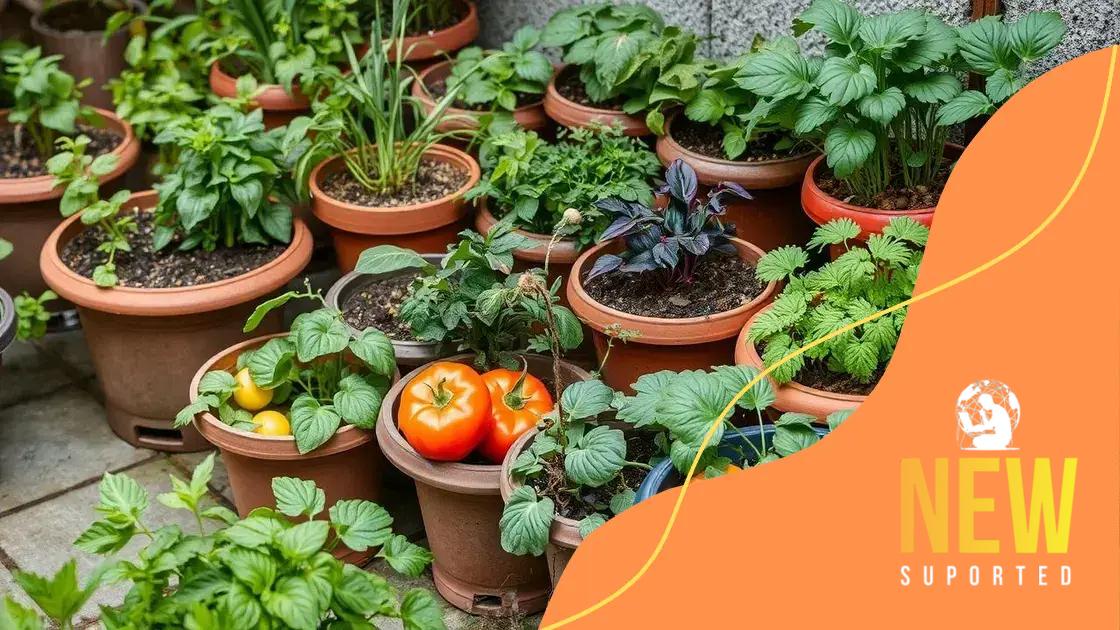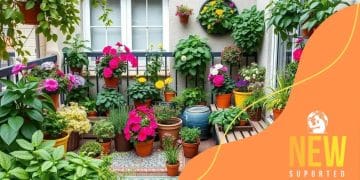How to grow an edible garden on your patio

To grow an edible garden on your patio, select suitable containers, choose plants like herbs and veggies, ensure proper watering and sunlight, and implement effective pest management strategies.
If you’ve ever wondered how to create a thriving edible garden, you’re in the right place. Growing an edible garden on your patio can transform limited space into a fresh food haven. Let’s dive into some practical tips that can help you get started.
Selecting the right containers
When it comes to growing an edible garden on your patio, choosing the right containers is essential. Proper containers will ensure that your plants have adequate space, drainage, and access to nutrients. This can greatly affect the success of your garden.
Start by considering the type of plants you want to grow. Different plants have different space and depth requirements. For example, herbs like basil and chives can do well in shallow pots, while vegetables like tomatoes may need deeper containers.
Types of Containers
There are numerous container options available on the market. Each type has its advantages and disadvantages:
- Plastic pots: Lightweight and durable, great for mobility.
- Clay pots: They are breathable and help regulate moisture levels.
- Fabric pots: These provide excellent drainage and air circulation.
- Wooden boxes: Ideal for creating a rustic look and suitable for larger plants.
Take into account the size of your patio and the amount of sunlight it receives. Larger containers generally retain moisture better and provide a more stable environment for your plants. Additionally, ensure the pots have proper drainage holes to avoid water buildup.
Adding a Personal Touch
Don’t forget to add a personal touch to your patio garden. You can paint or decorate your containers to match your home’s style. This not only enhances the visual appeal but also makes gardening feel more personal and inviting. Make sure that your container choice complements your overall patio design.
Ultimately, selecting the right containers is about balancing aesthetics with the needs of your plants. With the right choice, you can create a flourishing and beautiful edible garden on your patio that you will enjoy tending to.
Choosing edible plants for your patio
Choosing the right edible plants for your patio is crucial for a vibrant and productive garden. You want to select plants that not only thrive in containers but also fit your cooking and taste preferences. By considering these factors, you can create a mini-garden that brings joy and deliciousness right to your doorstep.
Begin by evaluating your climate and the amount of sunlight your patio receives each day. Some plants require full sun, while others thrive in partial shade. Understanding these needs will help you make informed decisions.
Popular Edible Plants for Patios
Here are some popular options that are well-suited for container gardening:
- Herbs: Basil, parsley, and mint are fantastic choices. They grow well in pots and can enhance your meals.
- Salad greens: Lettuce and spinach grow quickly and can be harvested multiple times.
- Tomatoes: Choose smaller varieties like cherry tomatoes for easy patio cultivation.
- Bell peppers: These colorful veggies can add flavor and nutrition to your cooking.
In addition to these, consider growing a few edible flowers like nasturtiums. They not only beautify your garden but also add a unique flavor to salads.
When planning your edible garden, think about companion planting. This technique involves placing compatible plants next to each other to enhance growth and deter pests. For example, basil pairs well with tomatoes, helping to improve their flavor and keep pests away.
Maintaining Your Edible Plants
To keep your plants healthy, ensure they have access to proper water and nutrients. Regularly check the soil moisture level and adjust your watering routine as necessary. Most container gardens need watering more often than traditional gardens.
Fertilizing is also important for container plants. Use a balanced, organic fertilizer to provide essential nutrients. Remember to follow the instructions to avoid over-fertilization, which can harm your plants.
Best soil and fertilizers for patio gardening

Using the best soil and fertilizers for patio gardening is key to growing healthy edible plants. The right soil mix provides the necessary nutrients and drainage that your plants need. It also helps retain moisture, which is especially important in container gardens.
When selecting soil, consider using a potting mix designed specifically for container gardening. These mixes typically contain a blend of organic matter, perlite, and peat moss, ensuring excellent drainage and aeration. This composition helps prevent root rot and encourages healthy root growth.
Essential Nutrients in Soil
Your garden soil should include essential nutrients such as nitrogen, phosphorus, and potassium. These elements are crucial for plant growth:
- Nitrogen: Promotes leafy growth and overall plant vitality.
- Phosphorus: Supports root development and flowering.
- Potassium: Enhances overall health and helps plants resist disease.
In addition to these nutrients, look for soil amendments like compost or well-rotted manure. These organic additions improve soil structure and fertility while promoting beneficial microbial activity.
Choosing Fertilizers
Fertilizers are essential for supplementing the nutrients that may be lacking in your soil. You can choose between organic and synthetic fertilizers. Organic options are often derived from natural sources and improve soil health over time.
When selecting fertilizers, consider the following types:
- Slow-release fertilizers: These gradually supply nutrients over time, reducing the frequency of applications.
- Liquid fertilizers: These are fast-acting and can be applied directly to the soil or as a foliar spray, providing immediate nutrient access.
- Organic fertilizers: Compost tea or fish emulsion can offer a nutrient boost while promoting healthy microbial life in the soil.
It’s essential to follow the manufacturer’s instructions when applying fertilizers to avoid over-fertilization, which can harm your plants. Regular monitoring and adjustment of your soil and fertilizer regimen will help you maintain a flourishing patio garden.
Watering and sunlight requirements
Understanding the watering and sunlight requirements for your patio garden is crucial for healthy plants. Each plant species has specific needs, and meeting these requirements will help ensure they thrive. Proper watering practices can prevent issues like root rot and dehydration.
Start by assessing the sunlight your patio receives. Most edible plants prefer at least six hours of sunlight daily. Observe your space throughout the day to determine which areas receive direct sunlight and which remain shaded. This will help you decide where to place your pots.
Watering Guidelines
Watering should be consistent but not excessive. Here are some key points to remember:
- Check the soil moisture: Stick your finger about an inch into the soil. If it feels dry, it’s time to water.
- Water early or late: Watering in the early morning or late afternoon helps avoid evaporation during the hottest parts of the day.
- Use a drip system: Consider installing a drip irrigation system. It delivers water directly to the roots, promoting efficient usage.
As the seasons change, you may need to adjust your watering schedule. In hotter months, plants will require more frequent watering, while during cooler months, you can reduce it.
Sunlight and Plant Placement
Different plants have varying sunlight requirements. For example, herbs and leafy greens often thrive in partial sun, while tomatoes and peppers enjoy full sun. Grouping plants with similar sunlight needs can simplify your gardening tasks.
Don’t forget that container color can also affect how much heat the plants receive. Darker containers may absorb heat, keeping the soil warmer, which some plants enjoy. Consider rotating your pots if you notice some plants struggling in the heat.
Maintaining the right balance of water and sunlight is essential to creating a flourishing edible garden on your patio. With attentive care, you can enjoy a vibrant and productive space.
Pest management in small gardens
Pest management in small gardens is essential for keeping your edible plants healthy and productive. Even in limited spaces, pests can be a challenge, but there are effective strategies to protect your plants without relying on harsh chemicals.
Start by monitoring your plants regularly. Look for signs of pest activity, such as small holes in leaves, discolored foliage, or wilting plants. The sooner you catch a problem, the easier it is to manage. Early detection is key to effective pest control.
Preventive Measures
Implementing preventive measures can reduce the likelihood of pest infestations:
- Choose resistant varieties: Some plant varieties are bred to be more resistant to pests. Research breeds that adapt well to your climate.
- Maintain cleanliness: Keep your patio garden tidy. Remove dead leaves and debris where pests can hide.
- Encourage beneficial insects: Ladybugs and lacewings feed on common garden pests. Attract these helpful insects with native flowering plants.
Using companion planting is another effective method. Some plants can repel pests when grown together. For instance, planting marigolds with vegetables can deter nematodes and other harmful insects.
Organic Pest Control Options
If pests do appear, consider organic control methods that are safe for your plants and the environment:
- Neem oil: This natural pesticide disrupts pest reproduction and feeding, helping to reduce their numbers.
- Insecticidal soap: Effective against soft-bodied insects like aphids, this soap suffocates pests without harming your plants.
- Garlic spray: A homemade spray made from garlic can keep pests at bay due to its strong smell.
It’s important to apply these treatments in the early morning or late evening to avoid harming beneficial insects. Always follow the instructions carefully to ensure safe and effective use.
By staying vigilant and employing these pest management strategies, you can enjoy a healthy and flourishing edible garden on your patio.
FAQ – Frequently Asked Questions About Growing an Edible Garden on Your Patio
What types of plants are best for a small patio garden?
Herbs, salad greens, and compact vegetables like cherry tomatoes and bell peppers are ideal choices for small spaces.
How often should I water my patio garden?
Water your patio plants when the top inch of soil feels dry, which is usually every few days during warm weather.
How can I manage pests naturally in my patio garden?
You can use methods like introducing beneficial insects, applying neem oil, or using insecticidal soap to manage pests without harsh chemicals.
Do I need special soil for container gardening?
Yes, use a high-quality potting mix designed for container gardens to ensure proper drainage and nutrient retention.






